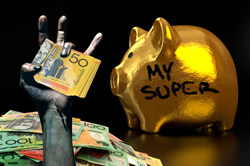As inflation bites and interest rates climb higher, says Ian Verrender* our precious super may not be worth as much as we think
 Regardless of what you think its value is, there’s a certain truth to the old saying that something is only worth what someone else is prepared to pay.
Regardless of what you think its value is, there’s a certain truth to the old saying that something is only worth what someone else is prepared to pay.
But there are many ways to manipulate a price which gives way to another equally aged maxim, coined by Oscar Wilde: A cynic knows the price of everything and the value of nothing.
As global stock markets have cratered in recent months — with serious falls across the globe after interest rates began their ascent — a lot of big-name investors have been left nursing near-fatal wounds.
In Australia, that’s translated into losses in our $3.2 trillion national savings pool — the retirement grubstake the bulk of our workforce squirrels each month via our system of compulsory superannuation.
For the first time in more than a decade — since the global financial crisis — most of us will be disappointed to learn that our super savings have shrunk.
Only three balanced funds managed to break into the black this year — Hostplus, QANTAS Super Gateway and Christian Super — and even then, they only just scraped across the line, with the first-place getter achieving a measly 1.6 per cent return.
Across the rest, the median result was a 3.1 per cent decline.
Terrible news.
Except, given what has occurred in the past six months, it actually is an astounding result, almost too good to be true.
In fact, it may well be too good to be true.
Have we escaped a train wreck?
Let’s just tally up the pain, shall we?
Most of it was delivered in the back half of the financial year.
The MSCI global index, which measures the performance of stocks in 47 countries, plunged 20.6 per cent in the June half.
That’s the worst performance since the measure was established in 1990.
Technology stocks have been among the hardest hit, with many of the big American names down more than 30 per cent and some off double that.
So too was anything that held out merely hopes of future profits, or companies carrying too much debt.
The Buy Now Pay Later crew has been transformed into Costing Now and Not Paying at all.
Then there are bonds.
These are debt securities — essentially IOUs issued by governments and big corporations — that trade on open markets just like shares.
The only difference is that the bond market is infinitely bigger than stock markets and far more important.
Normally, when stocks take a pummelling, bonds do well.
Not this year.
The most heavily traded global bond — which also happens to be the global interest rate benchmark — is the US government-issued 10-year bond.
It’s just notched up its worst performance since 1788, the year Captain Arthur Phillip sailed into Port Jackson to establish a penal colony.
There was even less joy among cryptocurrencies, down a whopping 61 per cent.
I could go on, but you get the picture.
Financial markets have been in a world of pain, unhinged by inflation, soaring interest rates and facing an uncertain future that may just have a big R attached to it.
So why did our Super hold up so well?
That’s where the magic of valuations enters the equation.
Assets that are actively traded on open markets, like property, stocks and bonds are easy to value.
The prices change daily as buyers and sellers battle it out and it is easy to put a number on their worth.
But our superannuation funds have large investments in assets and companies that aren’t listed or traded out in the open.
And so, valuing them becomes an arbitrary process — a matter of opinion.
In the wake of the global financial crisis, our large super funds made a deliberate decision to diversify their investments.
It wasn’t a bad idea.
Having been caught out by the near collapse of the financial system and the carnage that erupted in financial markets, many decided to put their cash into stable assets with long life spans, where the income stream was relatively immune from the economic ups and downs.
Infrastructure was an obvious choice.
Toll roads, ports, poles and wires, water, airports were all targeted.
Having hoovered up most of the world’s available infrastructure, they also began to look at a whole range of other assets.
Property, unlisted companies, new ventures and a range of alternative assets managed by what’s known as hedge funds and venture capital firms, also came into favour.
Many of our biggest superannuation funds have tipped around a quarter of our cash into these unlisted and alternative investments.
Again, because many are not listed on public markets, their values are deemed to be stable.
And that’s where the logic begins to blur.
For if the unit prices of listed property trusts collapse, shouldn’t it make sense that there be a corresponding downturn in the value of unlisted property trusts?
You’d think so.
But it doesn’t always work that way.
Where Canva and Klarna collide
For the past few years, Melanie Perkins, Cliff Obrecht and Cameron Adams have been feted as the young lions of Australian business.
In a little over a decade, the online graphic design outfit they created, Canva, has become a global phenomenon with claims it had built a customer base of more than 75 million in 190 countries — a feat that catapulted them into the rich lists.
The company isn’t listed on public stock exchanges.
It instead has funded its growth by raising money from private investors, including our big super funds.
In September last year, some Canva investors reckoned its value had doubled in just a few months to a whopping $58 billion, making it worth more than Telstra.
In the wake of Wall Street’s tech wreck this year, however, that has plunged.
The problem is that no one can agree on just how far its value has fallen.
Some say it now is worth $25 billion.
Others say, much higher.
Two of our biggest super funds, Hostplus and Aware, apparently can’t agree.
Not that either will reveal their valuations.
But it appears Hostplus has outsiders running the ruler over its unlisted investments — of which there are several thousand — while Aware values them internally.
Another investment firm, Franklin Templeton, publicly slashed the value of its stake in the company.
Others haven’t or, if they have, are keeping quiet.
The issue is further clouded because, in many cases, our super funds haven’t directly invested in these private companies.
They’ve invested in other investment funds, managed by Venture Capitalists and hedge funds.
These third-party funds, too, value their unlisted investments how they please, placing an opaque veil over a large slab of our superannuation performance.
It is that lack of transparency that should have regulators concerned.
For it also creates wealth transfers.
Those taking money out of super now — at potentially artificially inflated values — are being subsidised by those putting money in.
Concerns over private valuations recently came to the fore when Klarna, the Swedish Buy Now Pay Later operation in which the Commonwealth Bank has a stake, suddenly found itself in a valuation vortex.
When it attempted to raise extra cash by issuing new shares, it suddenly found the cupboard bare.
No one was willing to cough up at the price it was asking.
A year ago, it supposedly was worth $US45.6 billion ($66 billion).
Now, according to some estimates, it’s only worth $US6.7 billion ($10 billion).
How to inflate your performance — and your ego
That begs the question.
How much of the gains and losses in our super funds are plucked from thin air?
Markets, even open and public ones, often are manipulated.
You see it at the end of every quarter when global investment funds “balance the books” just before they report their quarterly performance.
But opaque, private investments open up a whole new world of opportunities.
One of the easiest ways for venture capital firms to talk up their book is to tip in, say, $10 million for a 10 per cent stake in a start-up.
A few months later, if everything is going well, it may opt to inject more money.
This time, however, it might invest $10 million for just a 5 per cent stake.
Why would you do that? It sounds like you’re short-changing yourself.
Well, no.
Not if you look at it in reverse.
Rather than say it has received only half the shares for the same amount of cash, the venture capital group instead says that its original investment has doubled.
It’s earned itself a 100 per cent return on that first tranche.
The investors in its funds, including our very own super funds, are ecstatic! A couple of months later, it does the same.
And so on.
Ever greater profits, all miraculously achieved through a multi-billion dollar thimble and pea trick.
What happens, however, when things turn sour?
The answer is, we don’t know.
But perhaps it’s time we did.
*Ian Verrender is the ABC’s Business Editor. A journalist for more than 30 years, Verrender began working in print in 1981 as assistant economist for Rural Press and later freelanced for The Bulletin before moving to AAP-Reuters.
This article first appeared at abc.net.au.











